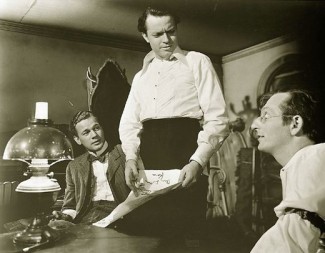Citizen Kane (Orson Welles, 1941): USA
Reviewed by Chloe Seaman. Viewed on DVD.
 Highly regarded as one of the greatest films of all time, Citizen Kane is just the third film directed by Orson Welles, preceded by Too Much Johnson and The Hearts of Age. It is obviously based on the life of newspaper tycoon, William Randolph Hearst, despite claims that it is rather a piece reflecting Americans of that era. Hearst was outraged at the outcome of this film that depicted him as a lonely man surrounded by a sea of people. He banned any mention of the film in any of his newspapers. Despite the hard hits it got by Hearst and the flop it was it the box office, Citizen Kane garnered nine Oscar nominations at the 1942 Academy Awards—including Best Picture—and won the Oscar for Best Original Screenplay (Herman J. Mankiewicz, Orson Welles).
Highly regarded as one of the greatest films of all time, Citizen Kane is just the third film directed by Orson Welles, preceded by Too Much Johnson and The Hearts of Age. It is obviously based on the life of newspaper tycoon, William Randolph Hearst, despite claims that it is rather a piece reflecting Americans of that era. Hearst was outraged at the outcome of this film that depicted him as a lonely man surrounded by a sea of people. He banned any mention of the film in any of his newspapers. Despite the hard hits it got by Hearst and the flop it was it the box office, Citizen Kane garnered nine Oscar nominations at the 1942 Academy Awards—including Best Picture—and won the Oscar for Best Original Screenplay (Herman J. Mankiewicz, Orson Welles).
The film opens with the death of a man – who we later know to be the main character, Charles Foster Kane (Orson Welles) – whose last word before he dies, dropping a snow globe from his hand, is “rosebud.” A reporter by the name of Thompson sets out to discover the meaning of Kane’s last word by interviewing the characters in Kane’s life that knew him best. But it is quite a contradiction because, as we begin to realize through a series of flashbacks, no one really knew who Kane was. He was someone with an enormous palace, but only had statues to fill it up. He was given up by his loving mother to live with a wealthy man who helped Kane to become the rich owner of the newspaper, the Inquirer. He tried his luck at politics, but when he left his wife for a much younger woman, he quickly restrained from the political world. He never seemed so happy in his life except as a child playing in the snow with his sled. As the mystery behind “rosebud” becomes more mysterious, Thompson concludes his search saying, “I don’t think any word can explain a man’s life.” But maybe it can… for Kane’s life.
A marvel for its time, Citizen Kane used a unique cinematic technique of having everything be in focus, from the foreground to the background. The camera was also for the most part tilted upwards at Kane to convey his powerful status and often looked down at the weaker characters such as his second wife Susan Alexander, a young singer pushed to perform on stage by Kane, despite negative reviews. The deep focus allowed every character to be in focus, giving them significance in the scene. There are several repeated scenes in which Kane in is the background but we still see him fully in focus as well as the characters in the foreground, just because he is a character with so much presence and significance. Everything in the story of the personal life of Kane revolves around him, from other characters to the topic of dialogue. This reflects the larger story–the mystery of “rosebud”–in which a frantic reporter is trying to figure out a man by just one word. There are a couple scenes that have the same sort of set up in which there are characters in either the foreground or middle-ground, or both, with Kane placed far in the background to the left. In one scene he is a young boy playing in the snow and in the other he is a young man dancing at a party.
As the story progresses and we see Kane becoming older and lonelier, the camera zooms back and shows Kane as being smaller in larger places. Though he remains in focus, he is shown to be more in the background of enormous rooms like his empty palace called Xanadu, with nothing but his voice echoing with the complaints of his wife.
Innovative and creative, Citizen Kane is just as interesting to analyze as it is entertaining to watch. There was so much thought that went into each shot so that cinematic elements, especially the cinematography, would reflect the greater emotions of the character and the story. I have a feeling that Citizen Kane will always be given the recognition it deserves for years to come.
12 Comments
Jump to comment form | comments rss [?] | trackback uri [?]